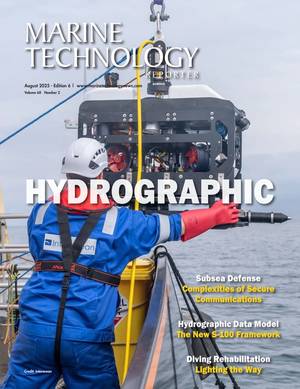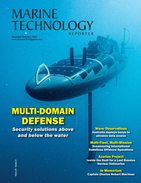Oceans Protection Treaty Could Take effect from January
The international treaty on the high seas, which focuses on conservation and sustainable use of maritime areas beyond national jurisdictions, has received sufficient support to take effect early in 2026, French President Emmanuel Macron said on Monday.
Speaking at the third United Nations Ocean Conference in Nice, Macron said 55 countries' ratifications of the treaty have been completed, around 15 are in progress with a definite date, and another 15 will be completed by the end of the year, meaning that the required 60 ratifications will be achieved.
"This means that this treaty will be able to enter into force on January 1 of next year, which means we would finally have an international framework to regulate and administer the high seas,” Macron said at close of day one of the conference, which is being held for the first time in Nice.
The High Seas Treaty, adopted in 2023, would permit countries to establish marine parks in international waters, which cover nearly two-thirds of the ocean and are largely unregulated. Hitherto, only an estimated 1% of international waters, known as the "high seas", have been protected.
The treaty comes into force once 60 countries ratify it.
Once the 60th ratification deposited, the treaty will enter into force after 120 days, setting the stage for the first-ever legally binding global framework to protect marine biodiversity in areas beyond national jurisdiction, according to the highseasalliance.org, which tracks the number of signatures.
At the end of May, after the European Union and six EU member states deposited their ratification at the UN, the number stood at 28.
At the opening of UNOC3 in Nice on Monday, U.N. Secretary-General Antonio Guterres urged world leaders to ratify the treaty.
Guterres cautioned that illegal fishing, plastic pollution and rising sea temperatures threatened delicate ecosystems and the people who depend on them.
"The ocean is the ultimate shared resource. But we are failing it," Guterres said, citing collapsing fish stocks, rising sea levels and ocean acidification.
Oceans also provide a vital buffer against climate change, by absorbing around 30% of planet-heating CO2 emissions. But as the oceans heat up, hotter waters are destroying marine ecosystems and threatening the oceans' ability to absorb CO2.
The drive for nations to turn years of promises into meaningful protection for the oceans comes as President Donald Trump pulls the United States out of climate projects and as some European governments weaken green commitments as they seek to support anaemic economies and fend off nationalists.
The United States has not yet ratified the treaty and will not do so during the conference, Rebecca Hubbard, director of The High Seas Alliance, said.
"If they don't ratify, they are not bound by it," she said. "The implementation will take years but it is critical we start now and we won’t let the U.S. absence stop that from happening."
Ocean experts have also seized on the conference as an opportunity to rally investment for the ocean economy, which has long struggled to attract sizeable funding commitments.
At a two-day gathering of bankers and investors in Monaco over the weekend, philanthropists, private investors and public banks committed 8.7 billion euros over five years to support a regenerative and sustainable blue economy.
Investments in ocean health totalled just $10 billion from 2015-2019 - far below the $175 billion per year needed, the U.N. has said.
To address this gap, the U.N. said on Sunday it was starting work to design a new financing facility, to be launched in 2028, which aims to unlock billions of dollars to restore ocean health by mobilising new and diverse sources of capital.
WHAT IS THE HIGH SEAS TREATY?
The treaty, signed in 2023, provides a legal framework for creating marine protected areas on the "high seas", or the ocean areas that lie beyond any national jurisdiction.
Currently, less than 3% of the oceans are under some form of protection, although altogether the world's oceans cover two-thirds of the planet.
The treaty contains 75 points covering areas such as protecting, caring for and ensuring responsible use of marine resources, and includes a provision for requiring environmental impact assessments of any economic activities in international waters.
The treaty also aims to ensure that all countries have fair and equitable access to the ocean's resources. While it is widely referred to as the High Seas Treaty, officially it is called the Biodiversity Beyond National Jurisdiction Treaty.
As of Monday, French President Emmanuel Macron said 50 countries had ratified the treaty, with 60 needed for it to go into effect.
Separate to the High Seas Treaty, countries agreed under a 2022 U.N. biodiversity pact to put 30% of their territorial waters under conservation.
WHY DO WE NEED AN OCEAN TREATY?
Oceans support coastal economies and livelihoods through tourism, fishing, shipping, mining, offshore energy and more.
Oceans also absorb about a third of the world's carbon dioxide, or CO2 - the primary gas driving climate change - while ocean-swimming phytoplankton provide about half of the world's oxygen.
But marine life is now struggling, and human industry and development are almost entirely to blame.
More than 1,500 ocean plants and animals are now at risk of extinction, and that number is expected to rise amid ongoing pollution, overfishing, ocean warming and acidification, according to scientists at the International Union for Conservation of Nature.
Additionally, new threats to ocean organisms and ecosystems could emerge in coming years in the form of deep-sea mining for rare-earth minerals.
In Nice, Macron is expected to urge countries to support postponing sea-bed exploration while researchers work to understand deep sea ecosystems.
Scientists are also concerned about the possibility that governments could look to modify ocean chemistry to boost its capacity for absorbing CO2 - a scenario that researchers say could help to limit global warming but could also have unintended consequences.
WHAT ELSE IS HAPPENING AT THE U.N. OCEANS CONFERENCE?
Macron is co-hosting this third U.N. Oceans conference with Costa Rica, and with at least 55 heads of state, business leaders and civil society groups expected to attend the five-day event.
Aside from discussions to advance the treaty, delegates are also expected this week to discuss overfishing, water pollution and other threats to marine life.
They'll also be looking for fresh ideas on how to pay for it all - with ocean-linked financing lagging far behind other sustainable investment areas.
For the five years spanning 2015-2019, ocean-related spending totalled $10 billion.
By comparison, the U.N. estimates that every year at least $175 billion is needed for marine protection.
The last U.N. oceans summit was held in Lisbon and co-hosted by Kenya in 2022. The next, co-hosted by Chile and Korea, is set for 2028.
(Reuters - Reporting by Manuel Ausloos and Clotaire Achi in Nice, Benoit van Overstraeten and Geert De Clercq in Paris, Virginia Furness in London; Writing by Richard Lough and Geert De Clercq; Editing by Hugh Lawson and Aurora Ellis) (Additional reporting by Virginia Furness, Editing by Katy Daigle and Hugh Lawson)













 August 2025
August 2025



